FACT CANNON: Provoking intelligent debate since the middle of last month. This time with some stuff about spider behaviour.
Different Worlds, Different People
The Earth is a very big place. Big enough, in fact, to exist at many levels of scale, each of which can be populated by many different types of people, inhabiting very different worlds. The people I want to talk about today are Pholcus phalangioides – let’s call them the ‘people’ of the spider world. These ‘people’ are probably busy in the Spider World in your house right now, keeping it free of bigger, hairier and potentially much more venomous spiders.
Pholcus Phalangioides – The Cellar Spider
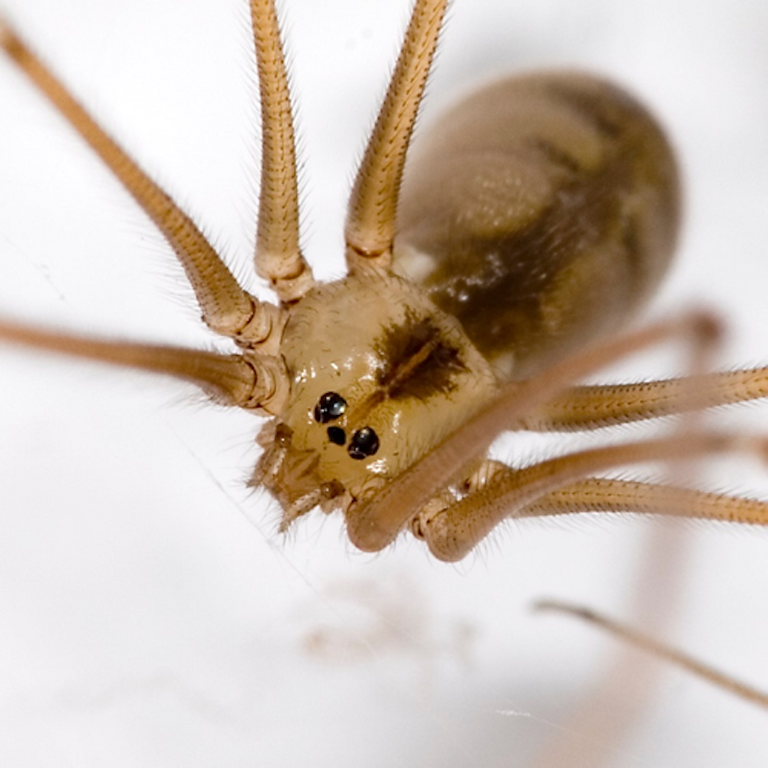
Pholcus is commonly known as the Cellar Spider, however in houses without cellars they tend to live in ceiling corners, or perhaps in dark nooks in cupboards, behind furniture or sinks. Pholcus seems particularly fond of bathroom ceiling corners above showers, which is where I first became aware of them when I moved into a new flat in the early 2000's. I don’t recall having seen them before then, and I remember it seeming odd how all of a sudden I started to notice them in everyone else's houses shortly after.
Given my somewhat tardy house cleaning habits in those days, this particular Pholcus remained in residence above my shower for a number of weeks, which gave me an ideal opportunity to observe her behaviour on a daily basis. Over the weeks of this initial encounter, and in the years which followed, I have witnessed a range of behaviours which I feel offer compelling evidence that Pholcus acts with a degree of intelligence, or at the very least with a great deal of sophistication.
Spider Behaviours
Drinking – Although normally Pholcus drinks by crouching down on its legs to dip its mouth parts into a drop of water, this appears to be an awkward and ungainly process. I have seen individuals who dwell above showers exhibiting a much more graceful solution. The spider will wait until the steam from the shower has condensed on its webs, and then use alternating legs to wipe across the web, and angle each leg into its mouth parts to sip the water. It is possible that the spider may also be cleaning its legs in the same process.
Vibrating – Pholcus is a relatively fragile looking spider – the main reason my family has come to know it as the ‘Spindly Spider’ or ‘Spindler’ – and so it has adopted a novel approach to defending itself from stronger predators. If you poke your finger into the corner of its web and jiggle it around a bit hopefully you will witness Pholcus’ primary defense mechanism, which is to violently vibrate its web so that it firstly appears much bigger, and then pretty much blurs out of visibility totally. Give it a try – it’s quite surprising.
Mating and Motherhood – Internet sources suggest that this only happens from June to September, although I am fairly confident that it can happen outside of these times. Perhaps it depends on the temperature the central heating is set at?
Over the years I have often noticed that the females’ knees sometimes turn a darker colour. I have no way of confirming this, but suspect that this either happens as an indicator to males that she is looking for love or when she is actually pregnant. Anyway, mating is an intricate business for Pholcus, and there is a clear courtship ritual. Males (sometimes more than one) tentatively approach the slightly larger female and when they are a few inches away they go through a variety of unusual three dimensional movements in the hope of impressing her. After a couple of hours one male will slowly edge closer, and engage in a little leg play, tapping front legs with her in a complex routine that can last for several minutes.
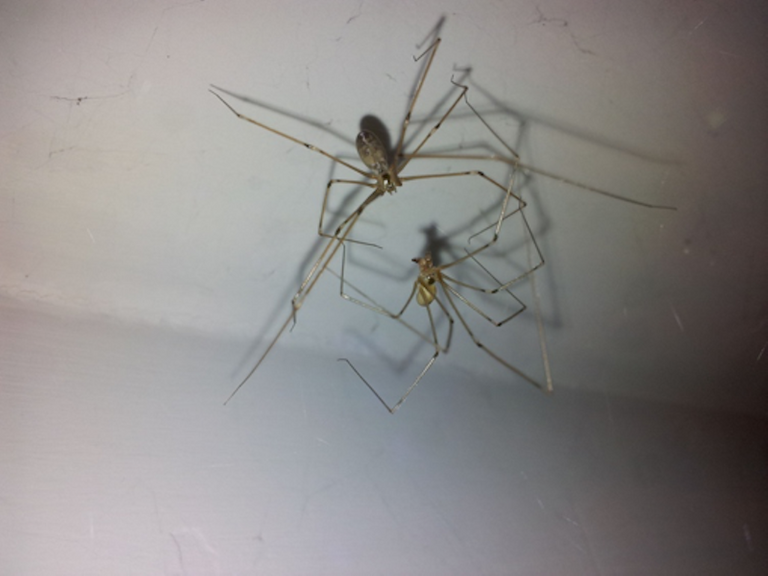
Although I have not witnessed it, I suspect the actual act itself is over very quickly. Lacking a penis, the male will whip in with his pedipalps (sort of mouth-based turkey basters, but fully equipped with the ability to taste and smell) and stick a little pre-prepared packet of sperm into her ‘receptacle’. Presumably he will then make a hasty exit before she changes her mind. Although Pholcus aren’t generally given to post-coital aggression, she is considerably bigger than him, and cannibalism is more likely to be on the agenda than sharing a cigarette!
A few days later our female spider will be seen clutching an egg sac in her mouth parts. She will carry this until the spiderlings hatch, which I think is roughly a month. If you find a spider in this state, have a look at the egg sac with a magnifying glass. If you catch it at the right time you will actually see the tiny spiderlings moving within the sac.
Once hatched, around 20-30 spiderlings will generally be found sharing the web with ‘mummy’ spider. I use this word advisedly, because the female really does appear to lavish tender maternal attention on her babies during this period. I have seen a mother spider manipulating webs, and gently coaxing wayward babies back into the fold with very intricate and gentle caresses of her front legs. After about a fortnight, and once the spiderlings start to grow, they will start to disperse and look for their own territories. Young spiders seem to tolerate each other’s presence nearby for around a month, and it can be fascinating watching them all grow at roughly the same rate as they moult and double in size roughly every week or so.
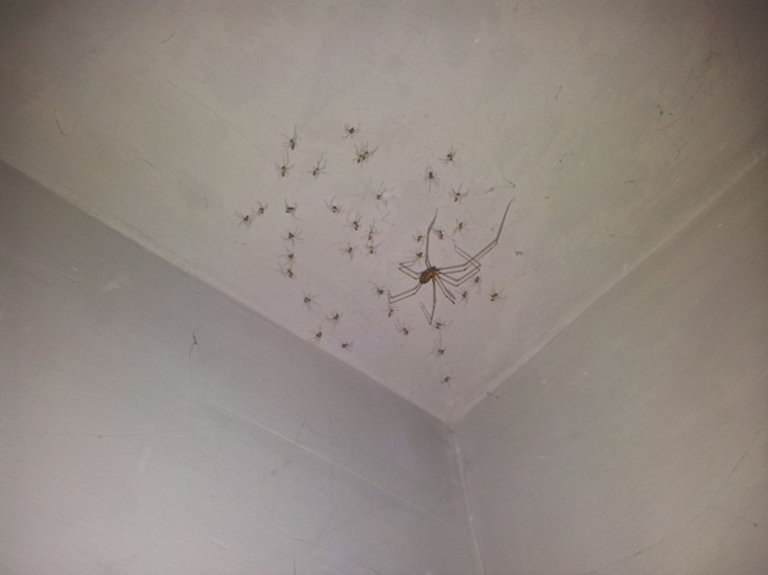
In part it is this tender maternal behaviour both before and after hatching, and the fraternal behaviour afterwards, that makes me think there is more going on here than one would initially imagine. These spiders don’t just mate and leave their egg sacs under any old stone! They genuinely appear to care for their young, and given the relative life expectancies of these animals I’d say their parenting behaviour is broadly similar to that of cats or dogs.
There is also something quite spell binding about watching a spider nursery tended by the mother over a period of days. At the end of it, once the young spiders have moved out, a patch of web full of tiny spider exoskeletons will remain. From our perspective this may seem a grim epitaph for a nursery, however if you view this from a spider’s perspective, this must be a place of great joy – for a spider an empty exoskeleton is a reminder that it’s occupant has successfully grown and moved on.
Moulting – I have only been privileged enough to witness this once over the last 15 years. On this occasion, a spider made an unusual web in the center of my bathroom ceiling, and then suspended itself from it about an inch clear of the aertex. The odd thing was that it almost appeared to have bound its legs together with the web, and pretty much strung itself up. Following this it erupted out of the back of its own thorax, with it’s ‘new body’ looking somewhat transparent. The whole episode was quite remarkable, with the suspended spider and its shed exoskeleton made a shape weirdly reminiscent of a viral bacteriophage.
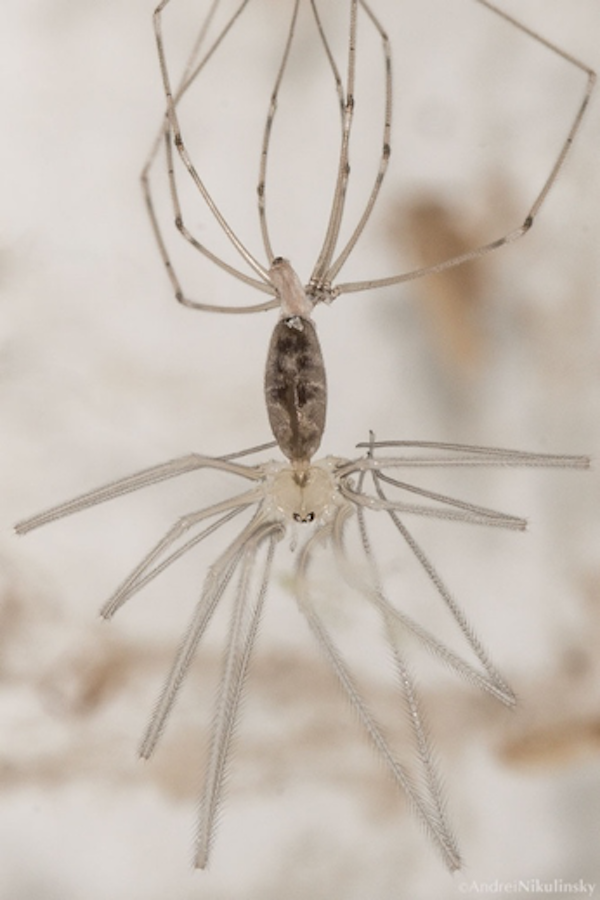
Hunting – So now we get to the crux of why I view Pholcus as the ‘people’ of the spider world. This is because one of Pholcus main food sources is other spiders. As I said earlier, although cannibalism does happen, it is generally a rare occurrence, taking place only under extreme conditions during times of food shortage. Pholcus instead much prefers to eat the brute ‘animals’ of the spider world, by which I mean species such as the European Giant House Spider (Eratigena atrica) which can have a leg span of up to 3 inches. Pholcus is also partial to beasts such as the Hobo Spider (Eratigena agrestis), Redback Spider (Latrodectus hasseltii) and Brown Recluse Spider (Loxosceles reclusa), all of whom are capable of inflicting necrotic and/or lethal bites to humans.
All of these spiders are much bigger and vastly more powerful and heavily built than Pholcus, and it is hard to believe that such a fragile looking creature would be capable of bringing one down – however, if you are lucky enough to witness Pholcus perform a take down, you will see that they remain very still while the bigger spider approaches, blissfully unaware that it is being watched, and when the unwitting beast strays close enough Pholcus will tense back and suddenly spring forward to inflict a lethal venomous bite with a burst of speed that is so quick it is pretty much impossible to see. Pholcus will then deftly wrap the beast in web as it rapidly succumbs to paralysis and loses control of its muscles.
Although I have never witnessed it myself, according to internet sources Pholcus sometimes also throws strands of web over the larger spider to bind it before the take down, and may also even lure them into a trap by vibrating their webs in the same way that their prey would.
It seems to me that perhaps Pholcus views these other species of spider as a food source in much the same way as we view cattle.
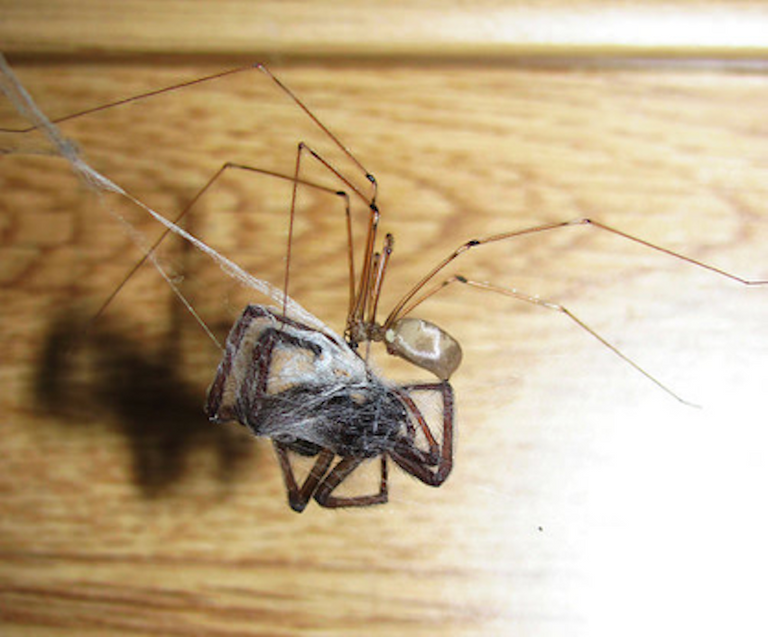
Other Pholcus Facts & Folk Lore
Naming confusion. Pholcus are sometimes known as Daddy Long-Legs. This name is best avoided however as it is also used to refer to the Crane Fly and the Harvestman arachnid.
Venom. Folklore says that Pholcus has venom that is lethal to humans, but they are unable to deliver it as their fangs are too short to penetrate human skin. This is incorrect on both counts – their fangs are plenty long enough, but the venom is too weak to be of any concern to us.
They’re pretty tasty if you happen to be a feline. Spiders are full of taurine (the stuff they put in energy drinks), and this seems to be particularly so for Pholcus during the mating season. The smell of taurine is irresistible to cats - who crave it to strengthen their heart muscles and keep their eye sight in good condition. Sadly, the result is inevitable. Vibrating doesn’t seem to scare off a hungry cat who will pursue Pholcus wherever necessary, which is generally into places you would rather they didn’t, particularly behind the television or PC where all the dusty, webby electrical cables are.
So, what do you think?
Do these observations stack up to spider intelligence? Would we find the same for any other species of spider or in fact any other type of creature if we studied it intensively enough? Does this mean intelligence is much more widely spread throughout the animal kingdom than orthodoxy allows? Are Pholcus comparable to ourselves, performing a role similar to our own in Spider World? Will this post make you think twice next time you’re tempted to step on one, or in fact any other living creature?
See also:
CHIN STROKER #1: Are you sure you're not a spider?
Taking spider and human consciousness that one step further.
Inspiration:
The ceiling above my shower
https://en.wikipedia.org/wiki/Pholcus_phalangioides
Previous editions of FACT CANNON:
FACT CANNON #1: Romanesco Broccoli, A Reality-Bending Vegetable
FACT CANNON #2: How Frankenstein Was Born In The Fiery Heart of A Super Volcano
FACT CANNON #3: The Sad Tale of Paul The Psychic Octopus
If you’re enjoying the FACT CANNON series, please upvote, comment, share and follow me. I'd love to turn this into a regular series, but as ever it depends on your support!
:-)
I trust no cats or spiders were harmed in the making of this video!
I really enjoyed this post like you
Glad to hear it, thank you!
Very interesting information! +1 Follower. :)
Thanks for your support! :-) Love your photos by the way!
Cool post, I can confirm your findings! I've been witnessing this kind of spider on my toilet ceiling! It's amazing how they can take down much larger spiders! :O That's why I let them live btw, they're natural exterminators ^^
Cheers!
Keep watching, they make fascinating ultra-low maintenance 'pets'!
Spider spider go away.
If possible I would not want to share my house with spiders.
A shame! The poor little chaps get a bad press. They really are fascinating if you watch them for a little while, but I know some people really don't like them, my brother just about craps his pants every time he sees one.
Just say that they are not really my cup of tea.
Great article. Reminds me of what my stepson would have done. My initial reaction would have been to kill it. Now I know better. Thank you.
Thanks, glad you liked it. :-)